
Brev med 10 udkast til ekslibris for bogtrykker Niels P. Thomsen 1912
0:00
0:00
drawing, graphic-art, print, paper, ink
#
drawing
#
graphic-art
#
art-nouveau
# print
#
paper
#
ink
Dimensions: 161 mm (height) x 303 mm (width) (bladmaal)
Curator: Welcome. We're standing before a drawing and print by Joakim Skovgaard, dating back to 1912. The work is titled "Brev med 10 udkast til ekslibris for bogtrykker Niels P. Thomsen," which translates to "Letter with 10 drafts for bookplates for printer Niels P. Thomsen." Editor: It’s fascinating how intimate this piece feels. Almost like peering over the artist's shoulder as they worked. The different iterations and handwritten notes create a sense of immediacy, revealing Skovgaard’s process. Curator: Exactly. Let's look at the formal composition. We have multiple bookplate designs, each a variation on a theme, unified by the "NP" monogram – for Niels Thomsen perhaps – nestled within decorative borders. Notice how Skovgaard uses line work to create depth and texture, particularly within the flourishes of the Art Nouveau-inspired foliage. Editor: Art Nouveau really emphasized integrating art with everyday life, right? The fact that these are bookplates, meant to adorn personal libraries, speaks to a desire to imbue even the most functional objects with beauty. The designs are very contained but the text is overflowing into something like notes on a commission or maybe some informal letter-writing? Curator: Indeed, bookplates served a symbolic purpose beyond mere ownership. They signified taste and intellect. Skovgaard's design incorporates not just stylized initials, but also heraldic elements evoking tradition and pedigree. But it also speaks to a period of cultural production heavily impacted by industrial methods. Editor: Looking closer at the handwritten notes around the drafts, there’s clearly a collaboration here. How does Thomsen, the printer, influence these designs? Is this a commentary on labour relations between an artist like Skovgaard and a printer in the burgeoning Danish book-printing industry? Curator: That’s a compelling interpretation, and not out of sync with the realities of print and craft labor dynamics at the turn of the century. Skovgaard walks a fine line here. The aesthetic choices convey prestige, but also nod to an industrial production model. Editor: I appreciate that the museum is displaying this fragile sketch not as a prelude to some final “masterpiece”, but for all the different forms of making and relating that it renders visible to us. Curator: Precisely. This piece captures a particular intersection between craftsmanship, artistry, and the culture of books during that era.
Comments
No comments
Be the first to comment and join the conversation on the ultimate creative platform.














